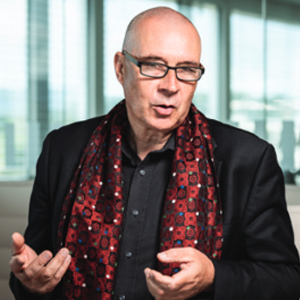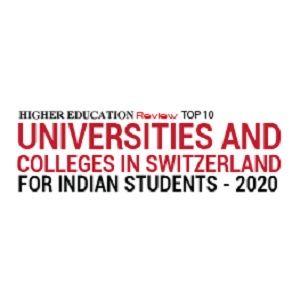Academy of Art and Design in Basel University of Applied Sciences and Arts Northwestern Switzerland HGK FHNW: GUIDING THE YOUNGER GENERATION OF DESIGNERS AND ARTISTS
By Michael Renner, Chairman
Visual communication has been a rather overlooked career option for many decades but with the recent technological advancements and innovations happening in the sector, the visual communication domain has been able to attract widespread attention. This gave a massive boost to the career options that educational path has to offer and various premier educational institutions have started to offer visual communication courses to meet the demand of aspiring students. Switzerland has always been at the forefront of adopting new technologies and they have been consistently developing its educational infrastructure to be agile and proactive. Leading visual communication education space of the country is the Visual Communication Institute, The Basel School of Design HGK FHNW. This one-off educational institute has been offering offbeat courses for the unique individuals who are smart and unique enough to go against the grain.
Adopting One-Off Teaching Methodologies
The courses offered by the Visual Communication Institute are unique and the curriculum is aligned perfectly with the industry requirements. The Master of Arts in Visual Communication and Iconic Research is one such unique program which is also the only Master’s program in design in Switzerland to award 120 ECTS, thus meeting all the requirements for enrolment in a PhD program. The program is founded on the conviction that, individually, neither a technical and craft-based design practice nor a theory-based reflection on visual messages is a sufficient basis for working in the modern field of visual communication. The institute believes that analytical, process-oriented design practice combined with a sound understanding of iconic and media theory and media technology is needed to create meaningful visual communication in a world which is globally connected but still locally experienced.
Another revolutionary course that is available in the Visual Communication Institute is an International Master of Design UIC/HGK (MDes/MAS). This course is a 4 Semester, 120 ECTS (60 US Credits), full-time program. The program is developed in collaboration with the University of Illinois, Chicago (UIC) and the Institute of Visual Communication at the HGK FHNW. It caters to students who want to be part of an international program of graphic designers, visual communication designers and media designers, with a bachelor's degree or an equivalent degree and professional design experience. Also, the students who pursue this course will graduate with a double degree. The curriculum of the course is influenced by the tradition of Swiss graphic design and the current academic perspective and standards of the Visual Communication Institute.
"The curriculum of the course is influenced by the tradition of Swiss graphic design and the current academic perspective and standards of the Visual Communication Institute"
Emphasizing on Research-Intensive Education
The Institute is involved in four different fields of activity:
(1) education on the Bachelor, Master (MA/MDes) and PhD level, (2) further training with the Basel summer and winter workshops, (3) research in the area of practice-led image and media research, historical visual communication research and research about design pedagogy, and (4) development projects for the industry. Adding more about the courses offered in the institute Michael Renner, Chairman, of the Visual Communication Institute says, “On the Bachelor level we focus on experimental basic design exercises and their application in practical design projects. In the Master of Arts and Master of Design programs, we build on the experience of the creative processes gained in the Bachelor studies. We extend them with the introduction to research methodologies and to theoretical aspects of the humanities and sciences. On the PhD level, the candidates develop a research project combining theoretical and practical aspects of Visual Communication.” The results of the research conducted by the institute are contributed to the communication and media design community and they are focusing on the question of how images and media create meaning in social interaction.
The Swiss were always known to be precise and specific at what they do and The Visual Communication Institute was instrumental in the development of the Swiss style and its international dissemination in the middle of the 20th Century. Many institutions have excluded the artistic and intuitive processes of design and have replaced them with methodologies of planning. In the Visual Communication Institute, the artistic, experimental and intuitive creative processes have been, and are still, considered as the central component to reach ‘objectivity’. “The main focus of our educations is the process-oriented, artistic and experimental, approach. Students learn, based on a thorough study of basic design to independently develop unique solutions for complex problems of visual communication and visual communication research. We educate our students on the development of cultural and social contributions to society through the creation of visual communication measures. Our students are learning to be innovative and are able to base their communication measures on ethical principles, creative processes and scientific knowledge. They learn to work in interdisciplinary teams and this helps the students to expand their horizons and improve their view of the world”, signs off Michael Renner.
Michael has first-hand experience working in the industry for Apple Computer. In 1999 he was named chairman of the Visual Communication Institute at the Basel School of Design (HGK FHNW). From 2005 until 2013 he was a member of eikones, the Swiss National Center in Iconic Research. His approach to developing research activities in the field of design is based on the aim to further develop existing competencies of image creation and is described best with the term ‘Practice-Led Iconic Research’. He is member of Alliance Graphique Internationale and the ad interim Dean of the HGK FHNW.
Adopting One-Off Teaching Methodologies
The courses offered by the Visual Communication Institute are unique and the curriculum is aligned perfectly with the industry requirements. The Master of Arts in Visual Communication and Iconic Research is one such unique program which is also the only Master’s program in design in Switzerland to award 120 ECTS, thus meeting all the requirements for enrolment in a PhD program. The program is founded on the conviction that, individually, neither a technical and craft-based design practice nor a theory-based reflection on visual messages is a sufficient basis for working in the modern field of visual communication. The institute believes that analytical, process-oriented design practice combined with a sound understanding of iconic and media theory and media technology is needed to create meaningful visual communication in a world which is globally connected but still locally experienced.
Another revolutionary course that is available in the Visual Communication Institute is an International Master of Design UIC/HGK (MDes/MAS). This course is a 4 Semester, 120 ECTS (60 US Credits), full-time program. The program is developed in collaboration with the University of Illinois, Chicago (UIC) and the Institute of Visual Communication at the HGK FHNW. It caters to students who want to be part of an international program of graphic designers, visual communication designers and media designers, with a bachelor's degree or an equivalent degree and professional design experience. Also, the students who pursue this course will graduate with a double degree. The curriculum of the course is influenced by the tradition of Swiss graphic design and the current academic perspective and standards of the Visual Communication Institute.
"The curriculum of the course is influenced by the tradition of Swiss graphic design and the current academic perspective and standards of the Visual Communication Institute"
Emphasizing on Research-Intensive Education
The Institute is involved in four different fields of activity:
(1) education on the Bachelor, Master (MA/MDes) and PhD level, (2) further training with the Basel summer and winter workshops, (3) research in the area of practice-led image and media research, historical visual communication research and research about design pedagogy, and (4) development projects for the industry. Adding more about the courses offered in the institute Michael Renner, Chairman, of the Visual Communication Institute says, “On the Bachelor level we focus on experimental basic design exercises and their application in practical design projects. In the Master of Arts and Master of Design programs, we build on the experience of the creative processes gained in the Bachelor studies. We extend them with the introduction to research methodologies and to theoretical aspects of the humanities and sciences. On the PhD level, the candidates develop a research project combining theoretical and practical aspects of Visual Communication.” The results of the research conducted by the institute are contributed to the communication and media design community and they are focusing on the question of how images and media create meaning in social interaction.
The Swiss were always known to be precise and specific at what they do and The Visual Communication Institute was instrumental in the development of the Swiss style and its international dissemination in the middle of the 20th Century. Many institutions have excluded the artistic and intuitive processes of design and have replaced them with methodologies of planning. In the Visual Communication Institute, the artistic, experimental and intuitive creative processes have been, and are still, considered as the central component to reach ‘objectivity’. “The main focus of our educations is the process-oriented, artistic and experimental, approach. Students learn, based on a thorough study of basic design to independently develop unique solutions for complex problems of visual communication and visual communication research. We educate our students on the development of cultural and social contributions to society through the creation of visual communication measures. Our students are learning to be innovative and are able to base their communication measures on ethical principles, creative processes and scientific knowledge. They learn to work in interdisciplinary teams and this helps the students to expand their horizons and improve their view of the world”, signs off Michael Renner.
Michael has first-hand experience working in the industry for Apple Computer. In 1999 he was named chairman of the Visual Communication Institute at the Basel School of Design (HGK FHNW). From 2005 until 2013 he was a member of eikones, the Swiss National Center in Iconic Research. His approach to developing research activities in the field of design is based on the aim to further develop existing competencies of image creation and is described best with the term ‘Practice-Led Iconic Research’. He is member of Alliance Graphique Internationale and the ad interim Dean of the HGK FHNW.


